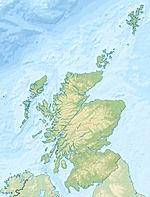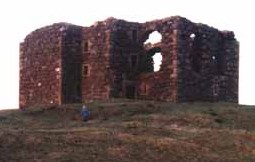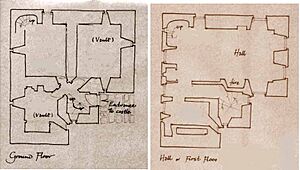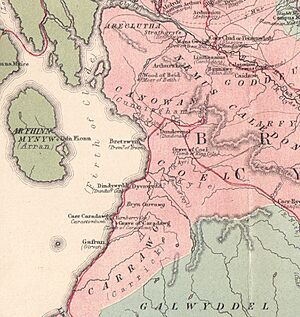Dunduff Castle facts for kids
Quick facts for kids Dunduff Castle |
|
|---|---|
| Dunduff, South Ayrshire, Scotland GB |
|

Dunduff Castle from the south following restoration
|
|
| Coordinates | 55°24′39″N 4°43′52″W / 55.410704°N 4.731241°W |
| Site information | |
| Owner | Private |
| Open to the public |
No |
| Condition | Restored |
| Site history | |
| Built | Circa 1696 |
| In use | 17th century |
| Materials | Stone |
Dunduff Castle is a cool old building in Scotland. It's a restored tower house, which means it's a tall, strong building with a staircase inside. It sits on a hill called Brown Carrick Hills, looking out over the sea and the village of Dunure.
Contents
Exploring Dunduff Castle's Past
The name Dunduff might come from old Gaelic words. It could mean "hill" or "fort" and "stag," like a deer. Another idea is that Duff was a person's name, so it would mean "Fort of Duff." It could also mean "Black Hill Fort" from the Gaelic 'Dun Dùbh'.
Some historians think Dunduff Castle is the same place as "Dindywydd." This place was mentioned by Aneirin, a poet from long ago, in one of his poems about King Arthur.
What the Castle Looked Like
This tower castle was built in an L-shape. It had a square stair-tower with three floors. On the ground floor, there were three rooms with curved ceilings. You could get to these rooms through the tower's entrance area.
A private room on the first floor was reached by a hallway. A fireplace in the castle wing kept the main hall warm. The windows and doors suggest the castle was built in the late 1500s or early 1600s.
Old maps show that a mill, called Dunduff Mill, was near the castle. This mill was also mentioned in old records from 1581. An 1808 map by William Aiton shows Dunduff Castle. However, it doesn't say it was a ruin, even though nearby Dunure was marked as one.
Why the Castle Was Left Unfinished
Records from 1696 say the castle was almost finished. But some people believe it was never fully completed. Maps from the 1500s to the mid-1700s show Dunduff Castle as a complete building. However, a map from 1775 marks it as a ruin.
So, it's not clear if Dunduff Castle was ever truly finished. A writer named Abercrummie described it as "a house on the coast never finished."
In 1891, a reverend named R Lawson wrote about the castle. He used it as an example from the Bible. He said it was like someone starting to build a tower but not having enough money to finish it.
Bringing the Castle Back to Life
The castle ruins were repaired and made stronger in the 1990s. The tower was completely rebuilt to be a family home. Ian Begg created the design for this restoration project.
The Owners of Dunduff Lands
Sir John de Graham was born on the lands of Dunduff in 1298. He fought alongside William Wallace during the Wars of Scottish Independence. Sadly, he was killed at the Battle of Falkirk. He was buried in Falkirk, and the famous poet Robert Burns visited his grave in 1787.
Dunduff was likely a castle of the Clan Kennedy. This family owned many castles in the area. A saying about the Kennedys goes: "Twixt Wigton and the toon of Ayr, Port Patrick and the Cruives O' Cree, Nae men need think fur tul bide there, Unless he court a Kenedie."
The first written record of Dunduff is from the time of William the Lion (1165–1214). Back then, Walter Champenais de Karrig gave some land at Dunduff to the monks of Melrose Abbey.
In 1581, the properties linked to Dunduff included 12 merk lands, the Dunduff grain mill, and other lands with their own mills.
The Stewart Family
The first owner of Dunduff was William Stewart. He was married to Isobel Ker. In 1528, he was the Scottish Ambassador to France. He passed away in 1552. His father was Sir Andrew Stewart, who was close to King James IV of Scotland. This family line could be traced back to King Robert II of Scotland.
William Stewart, the second owner, is mentioned in 1558. His wife was Elizabeth Corry. The family's real name was Stewart, but they often used "Dunduff" as their last name.
In the 1500s, there was a disagreement involving Matthew Stewart, the third owner of Dunduff. He and others had a dispute with the Earl of Culzean. On January 1, 1598, they tried to attack the Earl. However, he managed to escape unharmed in the dark streets of Maybole.
Because of this incident, Matthew Stewart was held in Edinburgh Castle for a short time. He was then told to leave Scotland, England, and Ireland. He also had to pay a large fine. However, this punishment might not have been fully carried out. Later, Matthew and the Earl settled their differences and became friends. Matthew passed away in 1609.
William Stewart was the fourth owner. In 1668, the last Stewart owner, John, and his brother William, were not allowed to renew an important agreement. This was because they supported the crown against Oliver Cromwell. Soon after, the property was sold to the Whiteford family.
The Whiteford Family
The Whiteford family owned lands in Paisley until 1689. Walter Whiteford was given lands by Alexander III of Scotland after his actions at the Battle of Largs in 1263.
James Whiteford of Dunduff (who died in 1697) married Isabel Blair. Another James Whiteford is mentioned in records from 1700 and 1714. A Bryce Whiteford of Dunduff (who died in 1726) married Elizabeth Cuninghame.
A James Whiteford of Dunduff owned lands in 1757. A "Lady Dunduff," who was Bryce Whiteford's widow, lived in Ayr in 1767 and died in 1775 at age 85. The title "lady" was often used to show respect to older widows of landowners. The Whiteford family also owned other estates. Today, the family lives in Shropshire, England.
Dunduff's Irish Connection
William Stewart, the fourth owner of Dunduff, was born around 1580. He became a baronet, which is a special title. Sir William asked for land in Ulster during the Plantation of Ulster. This was a time when King James VI and I (who was also King James I of England) encouraged people to settle in Ireland.
Sir William was given 1,000 acres (4 square kilometers) in County Donegal. This land was known as Coolaghy, and later as Fort Dunduff or the Manor of Mount-Stewart. Sir William had the power to set up land agreements and courts there.
Mount-Stewart later passed to the family of Alice Howard, 1st Countess of Wicklow. It's important not to confuse this Mount-Stewart in Donegal with Mount Stewart in County Down, Northern Ireland.
Dunduff Mill
Matthew Dunduff, also known as Matthew Stewart, took over the Dunduff corn mill in 1581. The mill got its power from one of the streams flowing off Brown Carrick Hill. However, its exact location is not known today.
The Dunduff Mill used a water wheel and a single pair of grinding stones. The sifting of the husks and blowing them away was done by hand. This is because the mill did not have machines for these tasks.
Archaeological Discoveries Near Dunduff
Dane's Hill Fort
About 170 meters west of the castle, there's a rocky hill called Dane's Hill. Historians believe it was an Iron Age fort or a motte (a type of castle mound). This structure has a deep ditch and two protective walls. Its sides are very steep and rocky.
Local stories say that the Danes fought here. People also believe the Danes built a castle at Dunure, a nearby village.
Old Coins Found
A large coin from Albert and Elizabeth of Bruges and Brabant (around 1630) was found near Dunduff Castle. It was discovered when the land was being plowed.
Dunduff Creek
The exact spot is now lost, but in 1655, a place called Dunduff Creek was used as a small harbor. It was located somewhere between Dunure and the Heads of Ayr.
Kirkbride Church Ruins
To the west of the castle, just past Dunduff Farm, are the ruins of an old church. This church was called Kirkbride and was dedicated to St Brigid, an Irish Saint. She lived around 453–525. Other churches in Ayrshire were also named after her.
In 1928, a cross carved on a stone slab was found among the church ruins. The stone had a special edge, and the cross had an unusual diamond shape cut out in the middle. It might have been a special stone used when the chapel was first built, possibly in the 1100s. No one knows where this cross is now.
The Kirkbride church was no longer used after its parish joined with Maybole. By 1696, it was already in ruins. Today, only some ruins remain, along with the churchyard and its gravestones. A field next to the church is known as the "Priest's Land." The cemetery was still used as late as 1903.






